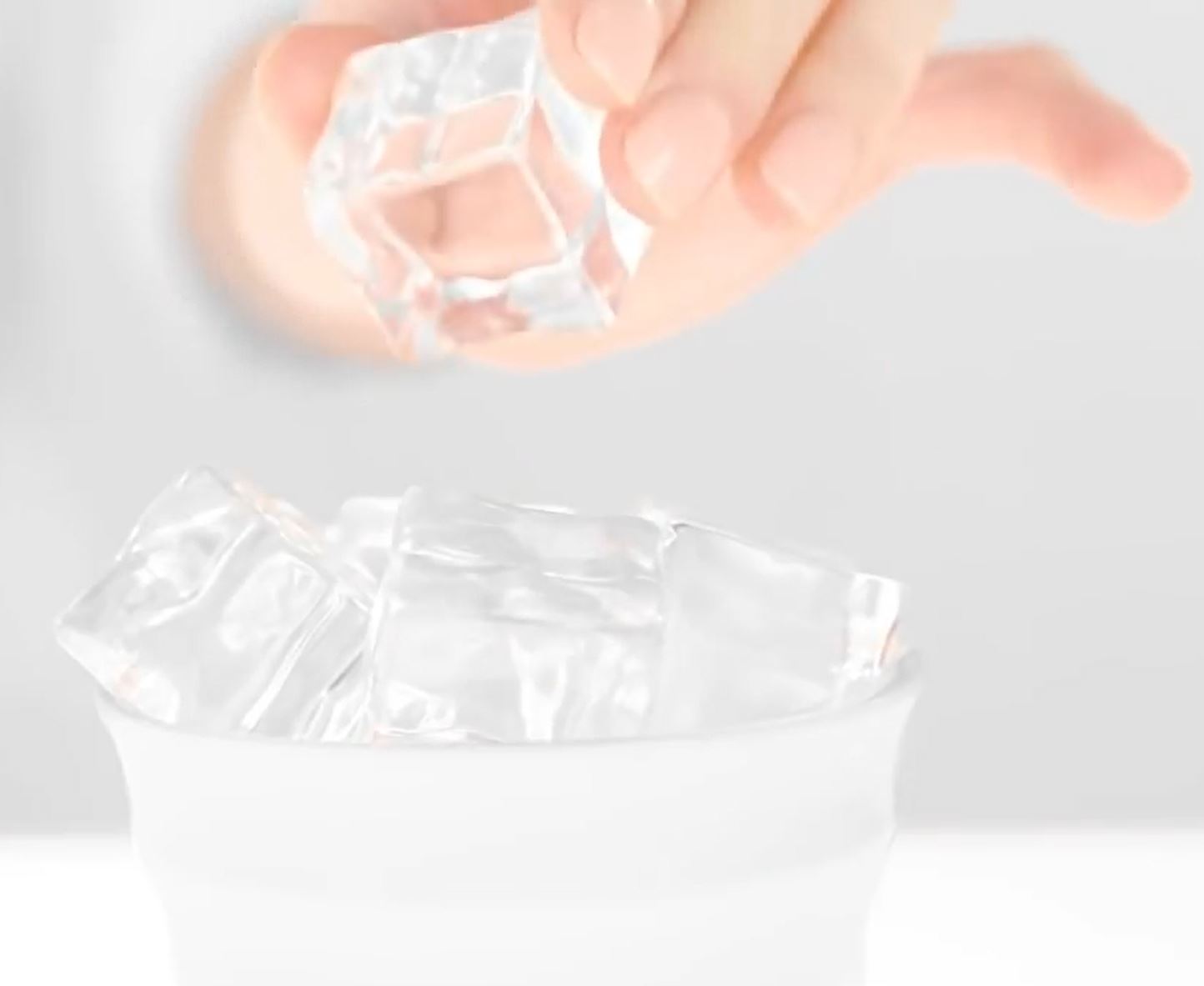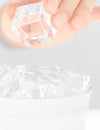Physics of Melting Ice in Shaken Cocktails
In a shaken cocktail, all the liquid ingredients typically start out at room temperature, which is around 76 F (25 C). The ice starts out at whatever temperature the freezer is set to, perhaps around 5 F (-15 C).
It is a common misconception that ice is always at 32 F. This is indeed the temperature that ice melts at, but ice can be any temperature lower than 32 F; in particular, the temperature of ice in a freezer will be at whatever temperature the freezer is set to.
The energy required to melt the ice comes at the expense of the energy in the liquid. The absorption of energy from the liquid by the ice, which results in melting of the ice, is what actually cools the surrounding liquid. In other words, ice cools water not because it is cold, primarily, but because it melts. The phase change from solid to liquid removes way more heat from the surrounding liquid that the coldness of the ice.
The ice continues to melt until the temperature reaches equilibrium, where the liquid and the remaining un-melted ice are all at the same temperature. If the liquid in question is pure water, this equilibrium temperature will be 32 F. If the liquid contains alcohol, this equilibrium temperature will be less than 32 F, as alcohol has a lower freezing point than water.
Once the liquid-ice mixture reaches equilibrium, no further melting takes place unless heat is transferred into the system through the walls of the shaker. In the case of Perlini, the walls of which are extremely good thermal insulators (which is why your hand doesn’t get cold when shaking it, as is the case with a metallic shaker), this is a very good approximation over the time scale of making a cocktail.
1. Calculation of Ice Melt
In this section we will calculate the total amount of ice that will melt during shaking a cocktail in a closed, insulated system like Perlini (though this result will apply to any method of shaking or stirring a cocktail). At the heart of this calculation is a simple expression of the First Law of Thermodynamics; i.e., the conservation of energy:
Whatever energy is lost by the liquid as it cools is exactly equal to (1) the energy gained by the solid ice as it warms, plus (2) the energy used to melt the amount of ice that melted.
In other words, whatever energy is lost by the liquid is gained by the ice, first to warm it up and then to melt it. So to put the above statement more succinctly:
(energy lost by the liquid) = (energy gained by the solid ice) + (energy used to melt the portion of ice that melted) (Eqn. 1)
Now, the amount of energy required to change the temperature of some mass of a substance by some number of degrees (which is measured in calories) is simply the mass of that substance (M) times the temperature change (ΔT) times the heat capacity of that substance (C). Heat capacity is a measure of how much energy it takes to change one gram of a substance by one degree C.
calories = mass x heat capacity x temperature change = M x C x ΔT (Eqn. 2)
Water has one of the highest heat capacities of any substance in the world, requiring one calorie of energy to raise one gram by one degree C. Having a high head capacity means it takes a lot of energy to change the temperature of that substance.
So, putting our word equation from Eqn. 1 above into symbols as in Eqn. 2 we get
(Ml x Cl x ΔTl) = (Mi x Ci x ΔTi) + (Mm x Cf) (Eqn. 3)
Where
| Ml |
= |
Initial mass of liquid |
| Mi |
= |
Initial mass of ice |
| Mm |
= |
Mass of melted ice |
| Cl |
= |
Heat capacity of liquid |
| Ci |
= |
Heat capacity of solid ice |
| Cf |
= |
Heat of fusion of ice |
| ΔTl |
= |
Change in temperature of liquid |
| ΔTi |
= |
Change in temperature of ice |
Eqn. 3 assumes that a) there is enough ice to completely cool the liquid to equilibrium, and still have ice left; and b) over the timescale of the trial, the Perlini acts as a perfect insulator.
It helps to think of Eqn. 3 this way. Imagine that the ice that is put into the cocktail shaker is sealed in a zip-lock bag. Further imagine that the ice warms up uniformly through the entire cube without melting until all of the ice is at 32 F. Then and only then does the heat from the liquid begin to melt the ice. The ice continues to melt until the entire system is at 32 F. The original liquid put in the shaker is now down to 32 F, and the baggie contains the remaining un-melted ice at 32 F along with the liquid water from the melted ice, which is also at 32 F.
Remember, we are after the amount of ice melt, which is Mm. Solving Eqn.3 for Mm, the mass of melted ice, we get
Mm = ((Ml x Cl x ΔTl) – (Mi x Ci x ΔTi)) / Cf
Now let's do an example. Assuming that the liquid in question is water, and that the liquid starts out at 24 C and cools to 0 C, and the ice starts at -12 C (about 10 F, a typical freezer temperature) and warms to 0 C. Let's say we start out with 100 g of water and 200 g of ice. So we have the following values:
| Ml |
= |
100 g |
| Mi |
= |
200 g |
| Cl |
= |
1.0 cal/g deg |
| Ci |
= |
0.5 cal/g deg |
| Cf |
= |
80 cal/g |
| ΔTl |
= |
24 C |
| ΔTi |
= |
12 c |
Then the amount of melted ice is
Mm = ((100 g x 1 cal/g deg x 24 deg) – (200 g x 0.5 cal/g deg x 12 deg)) / 80 cal/g
Mm = 15 g
This means that the amount of ice melt is 15 grams, or 15 ml. Thus, the amount of ice melt in this example is about 15%, and the total volume of the finished product is 115 ml.
The equation for alcohol water mixtures is somewhat more complicated, since the equilibrium temperature for a water/alcohol mixture is less than 32 F; and the degree to which it is lowered depends on the concentration of alcohol. It is further complicated by the fact that as the ice melts, the water/alcohol percentage goes up, changing the equilibrium temperature. This calculation is beyond the scope of this article.
2. Rate of Ice Melting
All other things being equal, both the rate of ice melt and the rate of temperature decrease of the liquid are approximately proportional to the temperature difference between the ice and the liquid. The rate starts off high at first, because the difference in temperature between the liquid and ice is at its greatest, and drops to near zero as the equilibrium temperature is reached and the solid and liquid components become closer in temperature. This type of behavior is ubiquitous in the physical world, not just in thermodynamics.
The extreme agitation of shaking a cocktail provides very intimate contact of the liquid and ice, ensuring an extremely rapid approach to equilibrium. Our experiments have shown that most of the cooling--and hence most of the melting of ice--takes place in the first 10 seconds of shaking.
To examine the proposition that most melting takes place during shaking, a known quantity of various concentrations of vodka, from pure water to pure vodka, was shaken for various durations over approximately 200 g of ice (e.g., the bottom half of Perlini filled with ice). After shaking, the liquid was removed from Perlini, its volume measured, and then quickly put back in Perlini over the same ice.
The increase in liquid volume, in milliliters, represents the amount of ice, in grams, melted during shaking. The mixture was then left to stand for an additional time in the Perlini, and the quantity of liquid was then measured again. In this manner, ice melt and liquid dilution can be measured over time, through the various stages of drink assembly, shaking, and resting.
In trials with 50 g of pure vodka at 76 F, and 200 g ice at 15 F, the result was an average of 70 g of liquid after shaking 10 sec, or a dilution of ~40%. After returning the liquid to the Perlini over the same ice, and letting it stand for another minute, the volume of liquid was less than ~75 g, or an increase of less than 10%.
3. Conclusion
Most of the ice melting takes place during shaking. Very little extra dilution takes place even after another minute, because the system is very close to equilibrium.






It is probably more accurate to say, in the last sentence, that very little additional melt occurs after the initial shaking because the system is at equilibrium, AND there is very little heat transferred from the room into the Perlini on the time frame of a minute or two.